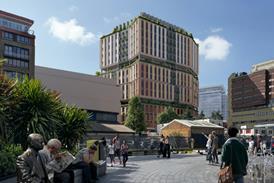Debbie McCreath on how student accommodation has evolved from basic lodgings to vibrant communities

Long gone are the days of dingy student digs with dim lighting, draughts, hard-worn carpets, linoleum, tired furniture, and shared bathrooms. The landscape of student accommodation has undergone a remarkable transformation over the past few decades. Purpose-built student accommodation (PBSA) today has evolved into a vibrant typology. Operators and developers are now delivering high-quality accommodation with bright, well-lit spaces, modern décor, and innovative bedroom designs, coupled with generous amenities. These well-thought-out spaces help create a community and provide a safe and secure place for students to call home. However, lingering memories of older student housing may still hinder perceptions of the sector, as many remember student accommodation as it was during their own university days.
What it was – reflections
Historically, student accommodation was basic and utilitarian, offering minimal comfort or privacy. These lodgings focused on the essentials—sleep, eat, wash, study—with little regard for individual needs. While this no-frills accommodation could encourage character building and camaraderie, it often came at the expense of student well-being. Perhaps the poor living conditions contributed to the disruptive behaviours often associated with students, who became products of their environment.
In the past, landlords held the power, cramming as many students as possible into low-quality accommodation for maximum profit. Now, choice is abundant, and students are voting with their feet. Operators are competing not only with each other but also with other products such as build to rent (BTR) and co-living. They are being forced to provide generosity, lifestyle support, and quality.
A new era of student living
The rise of PBSA marks a paradigm shift. Modern student accommodations now include en-suites, high-speed internet, and a plethora of amenity areas. There is a growing recognition of the importance of a supportive living environment for academic success and mental health. The evolution and improvement of student accommodation reflect broader societal and cultural shifts. Generation Z has grown up with technology and faced unique challenges, including economic uncertainties and the COVID-19 pandemic.
Today’s student population is more diverse than ever. Inclusive PBSA schemes focus on creating spaces that are accessible, welcoming, and functional for all students, regardless of their abilities and backgrounds. Developers and operators have responded by providing a range of sleeping accommodation options, from shared flats to luxury studios, and amenity spaces designed to support health and well-being, academic success, and community building. These buildings, with quiet study spaces, state-of-the-art fitness suites, and social spaces, create environments where friendships can be formed beyond the university curriculum alone.
Benefits and challenges
One of the many benefits of PBSA is its 24/7 management, providing support, peace of mind, and security for students and their families. This reduces the risk of isolation, particularly for those living away from home for the first time.
Striving for excellence, many operators now target BREEAM Outstanding ratings, making these buildings more sustainable and energy-efficient, aligning with Generation Z’s environmental awareness.
Offering diverse accommodation types can ensure inclusivity and reduce economic barriers
The benefits of PBSA extend beyond the students themselves. Partnerships between universities and private operators can alleviate housing pressures, freeing up shared houses for families. Additionally, out-of-term rentals and hiring amenity spaces for community events extend the benefits of PBSA to the wider community.
However, challenges remain. Premium facilities come with higher rents, highlighting the need for affordable options within these buildings. Offering diverse accommodation types can ensure inclusivity and reduce economic barriers to quality student housing.
Addressing misconceptions
The rise of PBSA represents significant progress in how we house and support the student population. However, misconceptions persist.
While student bedrooms in PBSA schemes are often criticised for being compact, clever designs can make these spaces functional and comfortable. Concerns have also been raised about the mental health of students and isolation within these buildings. Yet, they are designed to foster community, with on-site management teams providing pastoral care. The attention to amenity spaces supporting health and well-being should also be welcomed, and external spaces should be provided where possible, with a focus on creating environments that encourage learning and personal growth.
Some local communities remain hesitant to embrace student buildings due to noise concerns and the behaviour of students. However, on-site management provides an extra layer of safety, security, and discipline. Moreover, students’ interests are evolving, and the improvement of modern student accommodation reflects this shift.
PBSA is a forward-thinking solution to the evolving needs of today’s students. By addressing misconceptions and understanding the multifaceted benefits of these facilities, we can better appreciate their role in enhancing the student experience. The focus should be on collaboration to create buildings where students thrive, build lasting memories, and feel at home. Meeting the demand—such as for around 200,000 beds in London alone—will be key to fulfilling these goals.
Postscript
Debbie McCreath is an associate at PRP
















3 Readers' comments